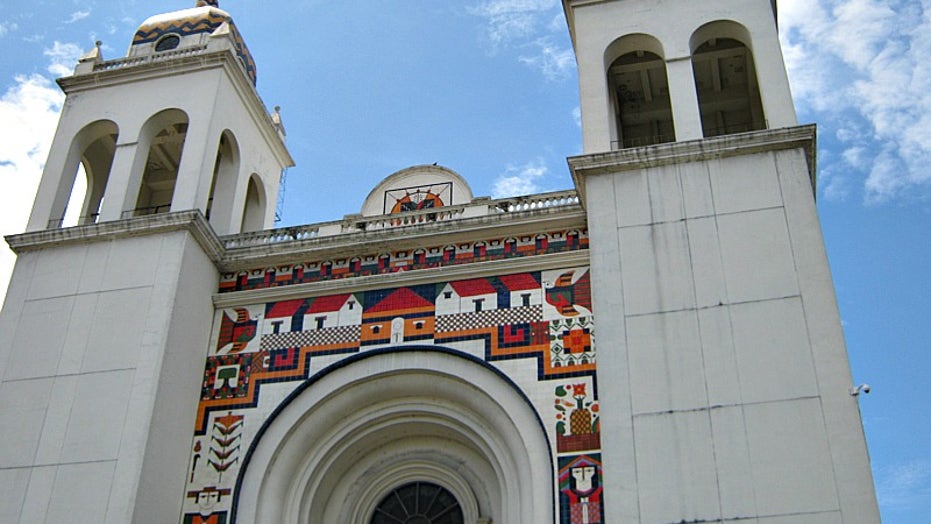Outside the historic Metropolitan Cathedral in San Salvador, workers sweep up broken hand-painted tiles which lay in a dusty pile. The tiles are scooped into large plastic buckets and dumped into another pile on the bed of a truck. These tiles were once part of a well-loved façade created by Salvadoran artist Fernando Llort and depicted, in his signature style, the colorful campesino motifs that have come to define Salvadoran folk art.
Being recognized as a National Heritage site apparently wasn't enough to save the mosaic made up of more than three thousand tiles from destruction. Home to the tomb of assassinated Archbishop Oscar Romero, the church itself was completed in 1999 after extensive renovations and sits atop the site of a cathedral that burned in 1956. A steady stream of visitors, including Pope John Paul II in 1983 and U.S. President Barack Obama in 2011, have paid their respects at the tomb of the Archbishop who is remembered for his humanitarian efforts during the Salvadoran civil war.
We're very sad…It was a decision they made without notifying us or consulting us.
This week, as workers swept in the background, the sound of broken tiles on pavement unmistakable, the adult children of artist Fernando Llort spoke to the press in front of the church that has been the location of historic funerals, warfare, protests and celebrations in this small Central American country.
"We're very sad," said Juan Pablo Llort, "…It was a decision they made without notifying us or consulting us."
With criticisms and questions in the air as to why the mosaic was taken down, and not only taken down but destroyed in the process, Tatiana Molina, architect of Molina Real Estate Services which owns the construction company hired by the Cathedral for the renovation, has spoken out.
Molina claims that the tiles were damaged and that the glue was no longer strong enough to hold the tiles in place, causing a hazard to pedestrians walking below.
However, if the tiles were as loose as to be in danger of falling, some argue, why were they not easily taken down with care and preserved instead of being shattered into pieces?
The current Archbishop of San Salvador, Archbishop José Luis Escobar Alas also spoke out, offering few logical explanations but extending his apologies to artist Fernando Llort and his family. "We thought about talking to the family [before the renovation], but we didn't do it," said Archbishop Alas.
Both the construction company and the Church admitted to not having asked permission from the Ministry of Culture or the mayor's office for removal of the art, a violation which could spur an investigation. To add to the controversy, the parish priest of the cathedral, William Recinos, claims that the mosaic was removed because it would clash with a marble statue of the Divine Savior by artist Camilo Bonilla that they plan to install on the roof; a claim Archbishop Alas has denied.
With the mosaic now damaged beyond repair, little can be done to right the wrong. This mosaic was truly owned by the people of El Salvador; a lack of funds at the time of its construction led the church to request donations from parishioners towards its creation. Thus, the destruction of the mosaic is not only a great insult to artist Fernando Llort, but shows blatant disrespect to the Salvadoran people who feel a sense of ownership toward the colored tiles that now lay scattered on the sidewalk.
"It's a shame that they destroyed this work of art," said a pedestrian named Ezequiel Urias in a report by Evelin Linares for ElSalvador.com."It was a work of art that Mr. Fernando [Llort] made with a lot of dedication," he continued, picking up a broken blue tile and holding it in his hand with other shards that he had collected. "Just knowing how much time it took and the effort that was put into it… it has great historic value."
A public letter written by Llort published January 3rd, said, in part, "The request of the Church to decorate the façade of the Cathedral is the greatest satisfaction that God has given me in my career. The destruction of that work by the Church is the saddest thing that ever happened in my life."
View pictures of the mosaic here.
Tracy López is a bilingual writer living outside the Washington DC metro area. She is the founder of Latinaish.com.
Follow us on twitter.com/foxnewslatino
Like us at facebook.com/foxnewslatino

